

European
Nuclear Society
e-news
issue 46: October 2014
Hinkley Point is a picturesque, isolated headland on the Somerset coast, in South West England. It lies at the edge of the gently rolling Quantock Hills, England’s first officially nominated ‘Area of Outstanding Natural Beauty.’ At first sight this idyllic backwater seems more likely to induce passion among birdwatchers, archaeologists and geologists (due to the important Bronze Age and Iron Age excavations discovered there), than among the European officials, politicians and activists that populate the Brussels bubble. But closer scrutiny reveals an altogether different story.
Nuclear power and Hinkley Point have enjoyed a close association for a long time. Indeed, nuclear power has been an important feature of the industrial landscape in this part of rural England for almost 50 years. Hinkley Point A, a now decommissioned former Magnox power plant, began operating in 1965. Hinkley Point B, a 1,250 MWe advanced gas-cooled reactor (AGR) began operating in 1976 and is still going strong today. So, the decision by EDF Energy to build two new EPR reactors at Hinkley Point C (HPC) seemed a very logical one.
However, EDF’s plan to construct the first nuclear reactors on British soil for 25 years was no ordinary industrial venture. It proposed a new and potentially ground breaking investment financing model called the ‘contracts for difference’ model (CfD) that that addressed the market’s failure to provide potential investors with a sufficient signal in favour of low-carbon energy alternatives to coal and gas. It aroused significant interest in the Brussels bubble. The EC decided that it needed to assess whether the HPC project contravened EU competition law. The enormity of what was at stake was not lost on either the advocates or the opponents of nuclear. Clearly, were the project to get the green light from the EC, a new nuclear age in the UK would be ushered in. HPC would create 25,000 jobs during construction and 9 00 once operational. It would boost the UK’s GDP (gross domestic product) by over €6 billion per year and generate about €130 million per year for the local economy. It will also create a lasting industrial benefit and provide reliable, low-carbon and affordable electricity for 5 million homes for up to 60 years. Suddenly, that sleepy part of South West England was catapulted from virtual anonymity (unless you happen to be a native of Somerset) to the centre of the EU energy policy arena.
However, HPC’s significance stretches far beyond the borders of the UK. It is more than a standard-bearer for the UK’s ambitious new build programme, even though that in itself is quite a responsibility. The impact of a positive judgement on the whole European nuclear industry could be considerable. A number of countries in Europe are planning to build new reactors. Poland recently took the decision to go nuclear for the first time and is carrying out a site selection process. Not surprisingly then, countries with a vested interest in the EC’s HPC judgement watched intently to see what colour smoke would rise from the Berlaymont building in Brussels. Indeed, rarely has a judgement of the EC been the subject of such intense interest and media speculation. On the other hand, had the project been deemed contrary to EU competition law, this would have been a major setback for the UK, and potentially for Europe’s aspiring nuclear nations.
In October the EC announced, much to the relief of both EDF Energy and the whole European nuclear fraternity that the HPC project conforms to EU competition law with regards to state aid. The sense of collective relief among all stakeholders was palpable. A massive obstacle to the realisation of the project had been removed.
Of course, the nuclear industry knows better than to count its chickens before they are hatched. It reacted with measured satisfaction rather than euphoria. The EC’s ruling does not mean that the matter has been settled once and for all, far from it. Indeed, one EU Member State (Austria) has declared its intention to lodge a legal appeal against the ruling. The investors still have to be found and there is a long way to go before the first electricity generated at Hinkley Point C is connected to the grid. However, the approval of the project is unquestionably a major shot in the arm for the industry. It may well prompt other interested countries to follow suit and adopt a similar approach to finding the investors that are the life blood of new build projects. Furthermore, the favourable ruling has given fresh momentum to nuclear new build as a whole and put a spring in nuclear’s step. It might also have helped answer those tired old clichés that ‘nuclear is an outdated industry’ and ‘a relic of the past’.
From a nuclear science and research perspective the news is equally welcome. A negative outcome could have badly impacted upon public acceptance and generally dented the confidence of the whole nuclear community. Instead, a new wave of optimism could help to maintain Europe’s global leadership role when it comes to reactor technology and engineering. This position has been earned due to the cutting edge research that the nuclear science community has carried out over the decades and to the technological expertise that it has nurtured. That research can now proceed with renewed impetus. There are already a variety of reactor types being considered for the UK’s new build programme and by aspiring ‘new builders’ – EDF’s EPR, Westinghouse’s AP 1000 and GE Hitachi’s Advanced Boiling Water Reactor (ABWR) - to name but three. This, together with the research that is being carried out into Generation III reactors, illustrates how new build is here to stay. Current and future research will focus, among other things, on sustaining and promoting that reality. Its contribution to the achievement of this objective could prove to be one of HPC’s greatest legacies.
|
|
http://www.euronuclear.org/e-news/e-news-46/PIME2015.htm


PIME 2015 will take place from 1 - 4 March 2015 in Bratislava, Slovak Republic.
PIME, the conference on Public Information Materials Exchange, is the annual focal point for professional nuclear communicators all around the world. It is the only conference of its kind designed especially for communicators in the nuclear industry and research communities.
The PIME programme will revolve around a series of plenary sessions and interactive workshops.
PIME is simply a 'must' for all nuclear public information specialists wishing to enhance and share their know-how and explore possible new strategies.
MARK YOUR DIARY – Join us in Bratislava from 1 – 4 March 2015
PIME 2015 Conference Secretariat
organised in collaboration with
http://www.euronuclear.org/e-news/e-news-46/RRFM2015.htm


The RRFM 2015 Programme Committee is calling for both oral and poster presentations regarding
All key areas of the nuclear fuel cycle of research reactors - conversion to LEU fuels; fissile material supply; fresh fuel and targets: origin and status, qualification, fabrication; technical aspects of fuel in-core management and safety; fresh and spent fuel transportation; fuel and reactor licensing; spent fuel storage, corrosion and degradation; fuel back-end management including reprocessing.
Utilisation of research reactors – nuclear science and technology including support for nuclear power programmes, education and training, industrial and medical applications; research reactor networks and coalitions, strategic and business plans and other activities to improve the research reactor utilisation and sustainability.
Innovative methods in reactor physics and thermo-hydraulics – development and application of advanced computational methods and tools for core load management (including burn-up calculation), operational and safety analysis, and fuel cycle physics; benchmark exercises; nuclear data improvements.
New research reactor projects – planned and ongoing new research reactors projects; lessons learned from building and operating new research reactors; role of research reactors in developing nuclear competence to implement nuclear power programmes; research reactor projects to meet future demand for radioisotopes; development of national infrastructure necessary to implement new research reactor projects, including inter alia organization and management, uses and applications, stakeholder involvement, nuclear safety and security and human resources development.
Research reactor operation and maintenance – managing issues at either end of the facility 'bathtub curve' (commissioning, early operation and end of life/ageing related issues); refurbishment, long term operation and life-time extension; maintenance assessments and risk informed maintenance programmes; management systems; configuration management; procedure utilisation; communications and work control; design review and control; human resource development and training programmes; regulatory interface; public relations; management improvement programmes and performance monitoring.
Safety and security of research reactors - implementation of IAEA safety standards and security recommendations; review of national regulatory requirements on safety/security and of licensing activities: design review and upgrades including associated facilities (spent fuel storage facilities); safety analysis methods and approaches, including analyses of beyond design base accidents; security management; review of emergency and contingency plans; interface safety/security; threat assessment and design basis threat in RR security; nuclear safety and security considerations in the training and qualification of personnel.
Decommissioning and dismantling of research reactors and waste management – strategies and concepts; decommissioning planning; economics; efficiency improvement measures; licensing; dismantling technologies applied; decontamination and measures to reduce radiation exposure; radiation and environmental protection; treatment, storage and disposal of radioactive waste; logistics and transportation; running projects; lessons learned from ongoing and completed projects.
Mark your diaries and be a part of it! Upload your abstracts on www.rrfm2015.org before 15 November 2014.
Authors should submit their abstract text in English through the Abstract Submission System on Reference number ISBN 978-92-95064-24-9 |
organised in cooperation with: |
||
 |
||
http://www.euronuclear.org/e-news/e-news-46/TopFuel2015.htm


The TopFuel 2015 Programme Committee is calling for both oral and poster presentations in the following tracks:
Operation and experience
Transient Fuel Behaviour
Advances in designs, materials and manufacturing
Enhanced accident tolerance (ATF)
Modelling, analysis and methods
Used fuel storage, transportation and re-use/material recovery
Mark your diaries and be a part of it! Upload your abstracts on www.topfuel2015.org before 12 December 2014.
Deadline for draft paper submission: 10 April 2015 Email ALL correspondence to topfuel2015@euronuclear.org . Your abstract contribution will be included in the Conference Proceedings that will be posted on the ENS website: www.euronuclear.org with reference number ISBN 78-92-95064-23-2. |
|
Organised in cooperation with: |
|||
|
|||
http://www.euronuclear.org/e-news/e-news-46/hungary.htm

Several summer festivals are organised in Hungary every year. These festivals are very popular among young people. The 2014 Sziget festival was attended by 415,000 visitors. The programme included concerts and a variety other performances. In addition, several civil organisations also participated by organising a number of different activities.
The Young Generation Network of the Hungarian Nuclear Society set up a ‘nuclear tent’ at four different festivals this year (Sziget, VOLT, EFOTT and Campus), where they were visited by young people who wanted to learn and talk about nuclear energy. The discussions focused on the operation of the Paks NPP and on the extension of the NPP with new Russian units. Other topics of discussion, including fusion energy, also proved to be of interest to the festival-goers.
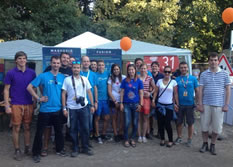 |
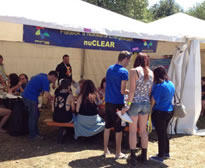 |
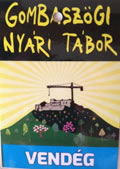 |
The Young Hungarian People in Slovakia organisation has regularly organised its summer festival in Gombaszög, close to the Krasnahorka castle. This year the organisers invited the President of the Hungarian Nuclear Society and a project leader of Greenpeace to take part in a debate on nuclear energy. The audience was very active, asking several questions about the safety of nuclear installations, the handling of nuclear waste and the advantages and disadvantages of renewable sources of electricity production.
The Hungarian Nuclear Society
http://www.euronuclear.org/e-news/e-news-46/slovakia.htm

Nuclear Societies do not often publish books. But the Slovak Nuclear Society does - not too often, but it does. The latest publication in question is a comprehensive monograph describing the nuclear fuel cycle. It is entitled – yes, you guessed it – The Nuclear Fuel Cycle. Here is brief glimpse of what you can read in the book.
Nuclear fuel is the source of the massive amount of energy that is produced in nuclear installations. The production of uranium, its processing and introduction into the fuel elements, its exploitation in nuclear reactors, its use in the proper reprocessing of used fuel and its final disposal are the key individual phases that make up the nuclear fuel cycle.
Uranium is a natural element with an abundance of 4 ppm in the Earth’s crust. Although it might appear that a nuclear reactor is a highly sophisticated piece of equipment that emerged as a result of the turbulent developmental years of nuclear physics in first half of the 20th century, and that its research was stimulated and accelerated by World War II, it has a natural analogy that was actually formed about 2 billion years ago. Natural conditions in the region of Oklo (Gabon, Africa) meant that after abundant rains or floods, water penetrated into geological formations that contained high concentrations of uranium and began to play the role of neutron moderator. The content of U235 isotope in the uranium deposits at that time was much higher than today’s 0.712 %, so no enrichment was required. The preconditions for a sustainable chain reaction of thermal neutrons had been created and heat was produced until the moderating water evaporated. Half a century ago radiographers found unequivocal proof in the form of evidence of sintered minerals, as well as high concentrations of radioisotopes. These could only have existed as a consequence of a chain reaction of nuclear fission. High concentrations of radioisotopes from Oklo, like those we try to immobilise in fixed matrices and dispose of in deep geological depositories, can serve us as a source of knowledge that can help us master the safe management of spent nuclear fuel.
The Nuclear Fuel Cycle describes in detail the front and back end of the nuclear fuel cycle, even though the numerous steps in the fuel cycle are not all carried out in Slovakia, and even though the final disposal of spent fuel in a deep geological depository in Slovakia has not been yet decided upon. The book primarily focuses on fuel for power reactors of the VVER-440 type that are currently in operation in the Slovakia. Our aim is to maintain operational experience with the mentioned fuel, to determine optimal operation and to evaluate the significance of individual thermo-technical parameters.
Safe nuclear fuel handling is, in our opinion, extraordinarily important, as are its monitoring, temporary storage and the back end of nuclear fuel cycle. Ensuring optimal spent fuel management, including its potential reprocessing and final disposal, is an essential task not just for us but for Slovakia too.
Juraj Klepac, Slovakian Nuclear Society
http://www.euronuclear.org/e-news/e-news-46/sweden.htm

On 22 September 2014, 100 Swedish nuclear representatives, primarily from industry and academia, gathered in the reactor hall of the first Swedish nuclear reactor, “R1”, 25 m underground in the central part of Stockholm, to celebrate the first ever criticality, which occurred on July 13 1954. The celebration also brought together nuclear pioneers from the time when the now decommissioned heavy-water reactor was in operation. Professor Emeritus Karl-Erik Larsson, 91, gave a much-appreciated talk on the groundbreaking research that he supervised at R1 in the late 50s. R1 was not only the first reactor to be developed by Sweden’s nuclear energy programme, but was also an important tool for neutron physics research as a whole. The experiments carried out at R1 attracted great interest on an international level and at least three Nobel Prize laureates were involved in research closely associated with it.
‘R1 proved to be a successful enterprise that paved the way for the development of the Swedish nuclear energy programme, a programme that had broad competence within the diverse knowledge field of nuclear energy,’ said Prof. Larsson.
Dr Maja Fjaestad, from the KTH Royal Institute of Technology, gave a talk on the connection between the R1 reactor and the nuclear power reactors currently in operation in Sweden today. During the decades after the Second World War, a new wave of optimism swept society, and the development of nuclear technology in the service of humankind was an obvious component of that bright emrging future. R1 was the first step along the so-called Swedish Line, according to which Sweden was supposed to be self-sufficient for nuclear energy thanks to the use of natural uranium and heavy-water reactors. However, global politics and technological development decided otherwise, and an industrial light-water reactor fleet was developed in Sweden during the 70s and 80s.
The celebratory events in the R1 reactor hall were followed by a dinner during which relatives of the early decision-makers involved in the development of R1, such as Harry Brynielsson and the former IAEA Director Sigvard Eklund, gave memorable speeches.
The event was organised by the Swedish Nuclear Society (SKS) and the KTH, with support from the Swedish Centre for Nuclear Technology (SKC).
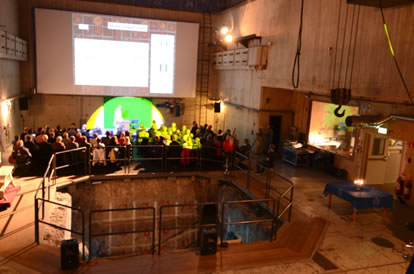
The Swedish Nuclear Society (SKS).
http://www.euronuclear.org/e-news/e-news-46/sne-news.htm


In July, the 8th International Young Nuclear Congress (IYNC 2014) took place in the city of Burgos, Spain. Jovenes Nucleares (JJNN), the Spanish Young Generation Network, was the host organization, and it benefited from the unconditional support of the Spanish Nuclear Society (SNE), our 'mother society'. They made the event possible, while at the same time showing the robust health of the Spanish nuclear sector.
IYNC conferences take place once every two years all over the world and since the first edition took place, in Slovakia 2000, it has visited all the world’s continents, except for Oceania.
For over two years JJNN had worked very hard in conjunction with the international team of organisers in order to bring this initiative to a successful conclusion. The JJNN team showed great organisation skills and team spirit.
There were two main targets that needed to be accomplished. Firstly, we wanted to encourage the exchange of knowledge between different generations and countries,
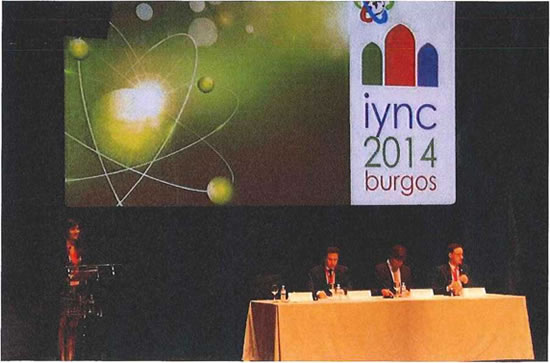
because sharing operational experiences results in an increase of safety at power plants. Secondly, it was important to strengthen the relationship between international network members, making it possible to establish stable links that will make communication easier in the future. In this regard, the local committee had striven to provide a unique atmosphere of ‘sociability,’ something that is easy to find in a country like Spain.
In short, the congress was a complete success, as most of the 380 attendees confirmed. All the objectives were accomplished.
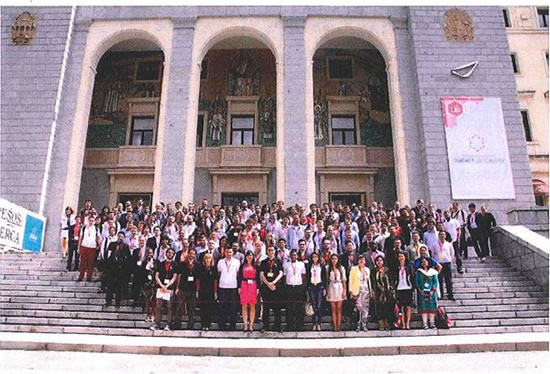
The first achievement that must be highlighted is the level of attendance - not only the total number of attendees, but also the great variety of the delegates. A large number of people answered our call to participate, including almost 20% from Asian countries like China, Japan, India and South Korea. This shows clearly the strong commitment that these countries have made to nuclear energy. There were also representatives present from countries that do not have a nuclear programme, such as Kenya or Nigeria. This also highlights the level interest that these countries have in nuclear technology.
Another important achievement was the ambitious congress programme itself, which was finalised and executed by the technical team. It consisted of 11 technical sessions during which nearly 250 papers were presented. Nineteen workshops covering the entire spectrum of topics from fuel cycle to women in nuclear and the importance of communications were also organised. We would like to highlight two sessions in particular, one regarding Fukushima, and the other that featured a showing of the film Pandora’s Promise, which was followed by a debate with the film’s director.
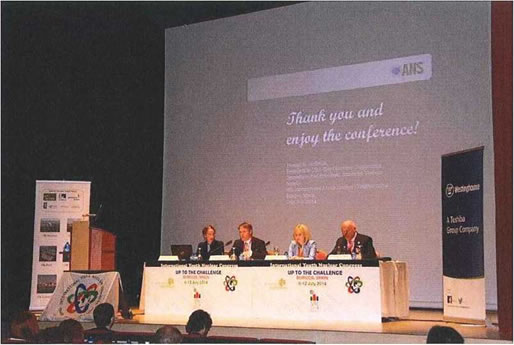
The interest and acceptance of the local media was also remarkable. They monitored the congress every day and provided a summary. The event was covered by local TV, radio and both the print and electronic press. This shows clearly the positive attention that is being paid to nuclear technology.
This proof of the strength of the commitment shown by young nuclear professionals from all over the world made us feel very optimistic about the future of nuclear energy. Such a degree of enthusiasm will propel us to the highest possible level of excellence. They have demonstrated that they are, without any doubt, ‘up to the challenge’.
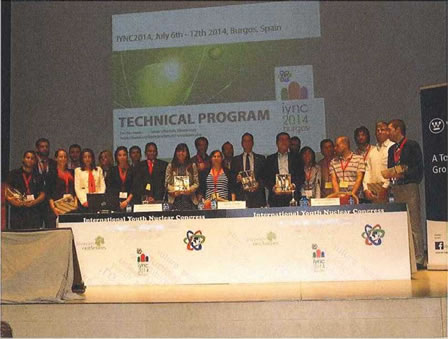
http://www.euronuclear.org/e-news/e-news-46/slovenia.htm

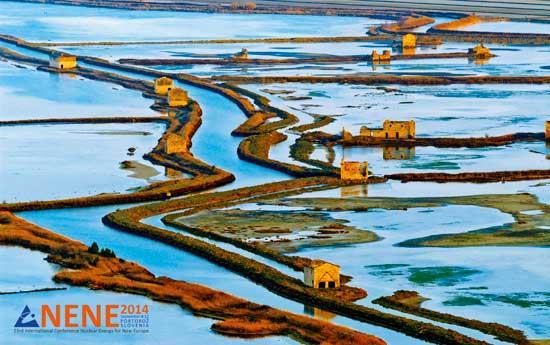
The 23rd international conference Nuclear Energy for New Europe 2014, which was organised by the Nuclear Society of Slovenia, was held in Portorož, Slovenia, from 8 to 11 September 2014. The conference was attended by 183 participants from 27 countries and international organisations.
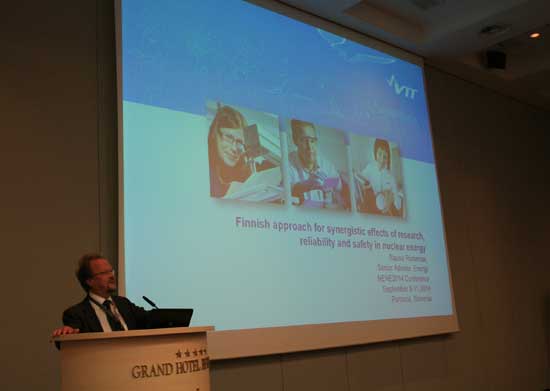
In addition to three distinguished keynote speakers (Rauno Rintamaa, Finland, Cristophe Behar, France, and Francesco Romanelli, UK) there were 47 oral presentations and 75 posters. They covered a wide range of topics, from reactor theory and safety analyses to practical experience of reactor operation, the role of nuclear energy in the society, as well as prospects for fusion energy. The programme of the conference and the abstracts are available at: www.nss.si/nene2014.
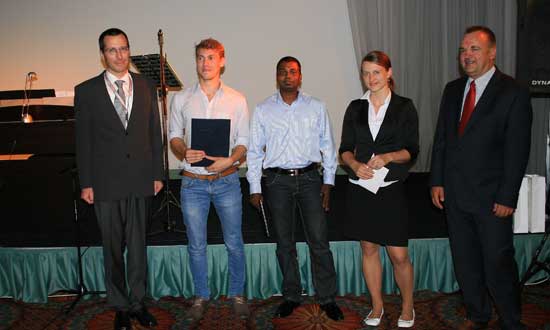
The Young Authors Competition and the Best Poster Awards are a well-established tradition at this conference. The Young Author Awards were presented to:
Hygreeva Kiran Namburi for the paper TEM Foils Preparation from Irradiated Austenitic Stainless Steel - An applied methodology, co-authored by Petra Bublíková and Vít Rosnecký
Žiga Štancar for the paper Thermal Power Calibration of the TRIGA Mark II Reactor, co-authored by Luka Snoj.
The Best Poster Awards were presented to posters entitled:
Pressurized Water Small Modular Reactor (SMR) Modelization and Severe Accident Analysis using ASTEC code, by Mirco Di Giuli, Marco Sumini and Giacomino Bandini
Validation of the neutron and gamma flux distributions in the JSI TRIGA reactor core, by Gašper Žerovnik, Tanja Kaiba, Vladimir Radulović, Anže Jazbec, Sebastjan Rupnik, Loic Barbot, Damien Fourmentel, Luka Snoj, and Jean-François Villard.
Naturally, the conference offered plenty opportunities for networking. A trip to the Sečovlje salt-pans further contributed to the relaxed atmosphere throughout the event.
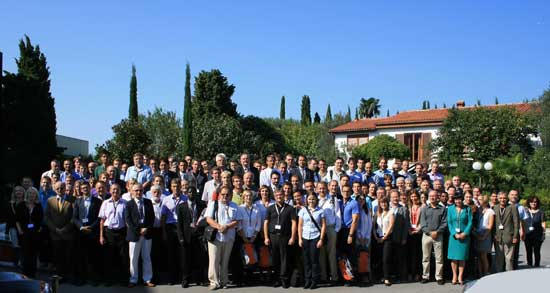
The next conference (www.nss.si/nene2015/) will again take place in Portorož, from 14 to 17 September 2015.
Dr Igor Jenčič
Chairman of the Programme Committee
http://www.euronuclear.org/e-news/e-news-46/rad4med.htm

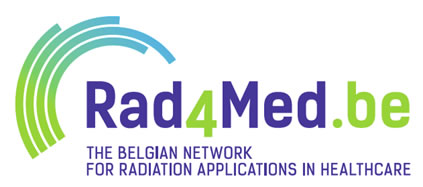
Rad4Med.be is the Belgian Network for Radiation Applications in Healthcare, a not-for-profit organisation aimed at creating awareness about the use of radioactivity in healthcare, improving its visibility and promoting Belgian expertise in nuclear medicine and radiation therapy. Rad4Mad.be therefore supports the worldwide development of a sector in which our country is a world leader. Rad4Med.be represents the entire value chain of nuclear applications in medicine, from the equipment for the production of radioisotopes or radiation beams to the final diagnosis and optimal treatment of the patient.
Rad4Med.be provides foreign stakeholders with direct access to the main actors and infrastructures in Belgium, so that issues relating to nuclear applications in medicine can be addressed within the country. Currently Rad4Med.be has over 50 members: universities, research centers, training centers, associations, agencies and companies working directly or indirectly in the nuclear field.
For more information go to: www.rad4med.be.
Contact: contact@rad4med.be
This network was created in 2013 with the support of:
BioWin, the Health Cluster of Wallonia, www.biowin.org/biowin/en/5408-home.html ;
The Belgian Nuclear Research Centre, SCK•CEN, www.sckcen.be/en ;
The National Institute for Radioelements, IRE www.ire.eu ;
Ion Beam Applications, Iba, www.iba-worldwide.com .

http://www.euronuclear.org/e-news/e-news-46/croatia.htm

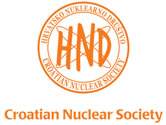
The Croatian Nuclear Society (HND), in cooperation with the International Atomic Energy Agency (IAEA), the European Nuclear Society (ENS), and the Croatian State Office for Radiological and Nuclear Safety (DZRNS) organised the 10th edition of the International Conference entitled: Nuclear Option in Countries with Small and Medium Electricity Grids. The Conference was held at Hotel Kolovare, in Zadar, a beautiful city on the Adriatic coast, from June 1st to June 4th 2014.
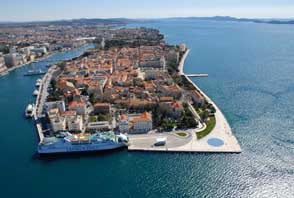
A total of 95 participants from 13 countries attended the Conference. 69 papers (10 invited and 59 regular), covering a broad range of topics (including power reactors and technologies, nuclear safety, reactor physics and fuel cycle, waste management, regulatory practice, and decommissioning), were presented during the Conference.
As a part of the conference programme, a Young Authors Contest was organized to motivate young authors to present their work. Two prizes were awarded to the best young authors.
For more information on the Conference, please visit the web site: www.nuclear-option.org
Croatian Nuclear Society
Dubravko Pevec
Secretary General
http://www.euronuclear.org/e-news/e-news-46/ygn-report.htm

The 8th International Youth Nuclear Congress (IYNC 2014) took place in Burgos, Spain, from 6-12 July 2014. The congress provided a platform for global networking for a new nuclear generation. The conference is hosted once every two years and is dedicated not only to young nuclear professionals, but also to their senior colleagues. The event’s objective is to enable the sharing of knowledge and experience between a culturally diverse audience that represents all six continents of the world.
Under the headline: ‘Up to the challenge’ the young nuclear generation present wanted to prove to the world that following the Fukushima accident they are ready for the new challenges ahead, such as improving safety standards beyond ‘unexpected events’, enhancing new technology and continuing with the renaissance of Gen-III reactors.
The congress started at the FORUM Evolucion Congress Center on the evening of 6 July, with registration and an Opening Reception that was followed by Welcome Drinks.
On 7 July, after the Opening Address and welcome speeches delivered by Nicolas Anciaux, IYNC 2014 President, and Raquel Ochoa Valero, IYNC2014 General Co-Chairman from the host country, the Opening Session got under way.
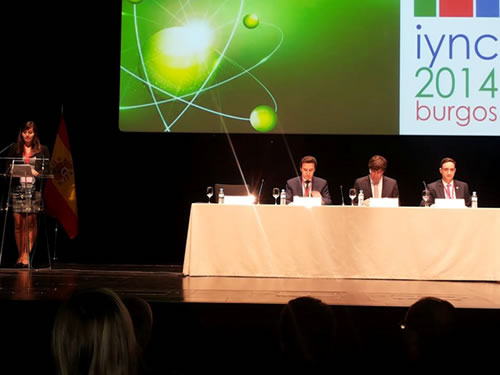
The Opening Session of IYNC2014 featured addresses from Francisco Lopez, President of the Spanish Nuclear Society, who delivered an inspiring message about the current state of nuclear energy in Spain and the challenges and opportunities that it faces, and Fernando Gomez Aguado, Deputy Mayor of Burgos, who welcomed the participants to the historic city of Burgos, the ‘Pride of Castile’ - one of the most beautiful cities in Spain. He also welcomed participants to the largest ‘youth nuclear conference’ on the calendar.
The Keynote Session featured outstanding invited speakers. Alejo Vidal-Quadras, a former Vice-President of the European Parliament, from Spain, delivered a speech about the main challenges facing nuclear, resources dependence, and the role of nuclear energy in the energy market. Another guest speaker, Danny Roderick, President and CEO, Westinghouse, USA, delivered a speech about Westinghouse’s business structure, new nuclear build in USA, the market fundamentals and the role of nuclear energy in the future. The main message for the nuclear young generation from Mr. Roderick was the need to set your “True North”. No one knows exactly what pathway our lives will follow, but to really achieve our goals, to reach our maximum potential, to live a full and rewarding life, we need to establish and hold on to our own set of values, our own True North.

Next up was the Country Reports Session, which provided another unique opportunity for the international Young Generation Network (YGN) member countries to share their national reports (more than 30 country reports featured brief summaries of nuclear developments and YGN activities in each country).
From Monday afternoon onwards, and for the rest of the week, the IYNC2014 continued at the Atapuerca Conference Center, which belongs to the ABBA Burgos Hotel.
The IYNC2014 conference programme featured excellent technical content. More than 70 speakers from 5 continents, most of them highly recognised experts or leaders of nuclear industry and R&D environment, presented their work. The Technical Programme session, which was chaired by Denis Janin, was based on three pillars: Technical Tracks, Workshops, andPlenary & Panel sessions. Its main objective was to ensure that every participant would go back home with meaningful and innovative takeaways from IYNC2014, while having at the same time expanded his or her network.
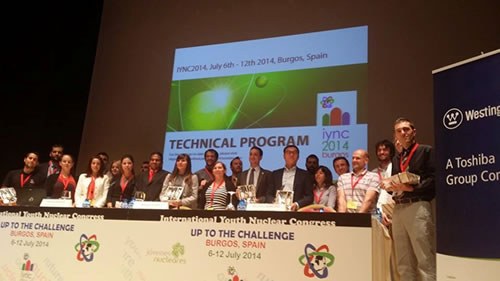
The Technical Tracks, chaired by Alberto Foronda-Delgado, enabled knowledge transfer among young and experienced professionals from all around the world, promoted networking, and contributed to the personal development of participants. There were 11 different technical tracks: Plant Operation and Maintenance, Design Modifications, Radiation Protection; New Reactors (Gen 3+ and SMRs); Reactor Physics and Materials (including Advanced Reactors, e.g. Gen 4); Nuclear Safety, PRA, Severe Accidents and Fukushima-related topics; Fuel Cycle front end and non-proliferation; Decommissioning, Waste Management and Fuel Cycle back-end; Nuclear Fusion; Training, HR development, Organizational Factors; Nuclear Politics and Economics, Communication, Social Acceptance; Nuclear Medicine and Non-Electric Power Applications and YGN Best Practices.
Participants had the opportunity during the 4 days to attend more than 140 oral presentations in 30 oral sessions, one poster session with more than 40 posters presented, and one related Special Session - the 8th 2014 ENEN PhD Event.
The best papers will be published in the Spanish Nuclear Society Journal and in the Nuclear Science and Engineering journal – a publication by the American Nuclear Society, published following a corresponding external peer review process.
Workshops, chaired by Crystian Ioppolo, were designed to provide a more interactive educational experience for IYNC2014 participants, as well as unique networking opportunities. There were 15 interactive workshops and 4 media training workshops, which together developed innovative concepts on various key topics.
The Plenary & Panel Sessions, chaired by Kristine Madden and Shengke Zhi, invited a number of world nuclear leaders, recognized experts and numerous youth leaders to share, learn and discuss the most popular topics from across the international nuclear sector. They gave a unique opportunity for participants to meet and debate with recognized industry leaders and experts on cutting edge topics for the energy and nuclear energy industry.
The showing of the film Pandora’s Promise, a groundbreaking new film about the myths and science behind nuclear energy, was introduced by Suzy Hobbs, and was followed by a debate with the movie’s director, Robert Stone.
The Fukushima Special Session, organized by Kenta Horio, provided the latest updates on the situation at Fukushima since the accident. Presentations from Japanese experts covered both onsite and offsite issues, including decommissioning, environmental restoration and regional revitalization. There were discussions on the challenges facing nuclear since the accident.
The 8th 2014 ENEN PhD Event Special Session was organized by the European Nuclear Education Network (ENEN), in cooperation with the Joint Research Centre (JRC) of the European Commission. They organize this PhD Event every year to highlight and reward the work of excellent PhD students.
The technical programme finished on 11 July. It was by followed by a programme of full-day technical tours: Tour 1 - Heavy Components Factory (ENSA, Equipos Nucleares S.A.), Tour 2 – Fuel Assembly Factory (ENUSA Industrials Avanzadas S.A.), Tour 3 – Santa Maria de Garona NPP (Nuclenor S.A.), Tour 4 – Control Room Simulators (TECNATOM), Tour 5 – Decommissioning of a Nuclear Power Plant (Jose Cabrera – Zorita), Tour 6 – Fusion Laboratory (CIEMAT). The technical tours provided a complete overview of the nuclear fuel cycle, from fuel assembly and components fabrication through operation to decommissioning and dismantling, as well as research centers and simulators for operators’ training.
The Social Events programme was very well organised. It was chaired by Silvia Ortega, and included following events: 6 July, evening – the Opening Reception in the FORUM Evolucion Congress Center; 7 July, evening - Portia Winery visit; 8 July, evening – a gastronomic tour in the Burgos center with a visit to the Cathedral; 10 July, evening – the Farewell dinner at the Coco Atapuerca restaurant and 12 July – a visit to a Bullring - the CAPEA.
On 9 July, evening, the IYNC Board of Directors meeting took place, during which the participants elected a new IYNC President - Melissa Crawford. The country that will host next conference, IYNC 2016, was also announced – China.
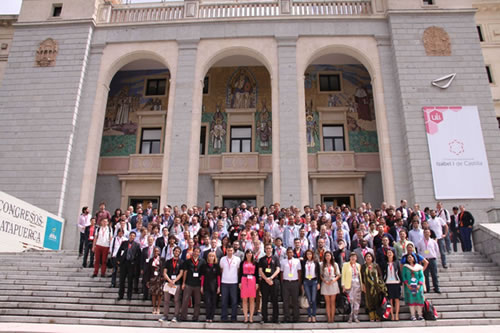
In my opinion, the International Youth Nuclear Congress 2014 was a professional and social success, due to the sharing of knowledge and experience between the nuclear young generation, the opportunity that was exploited to learn from senior nuclear professionals, the communicating within a truly international environment, and the great possibilities that it offered to develop further networks.
But of course, there is still room for improvement. Donald Hoffman, Immediate Past President of the American Nuclear Society, who spoke about leadership, reminded us of the need to “Think Out-Of-The-Box”. I can tell that this nuclear young generation is willing to explore things that are out of their comfort zone and to do everything they can to achieve a creative breakthrough.
I would like to thank very much ENSYGN and the IYNC Committee for the opportunity they gave me to participate in this congress. I wish IYNC2016 in China every success!
Denys Zeniuk
IS “AtomprojectEngineering”
NNEGC “ENERGOATOM”
YGN Ukraine
d_zenyuk@yahoo.com
http://www.euronuclear.org/e-news/e-news-46/ENYGF-2015.htm


The Atoms for the Future 2014 conference brought together, in France, more than 200 students and young nuclear professionals from all over the world (USA, UK, Sweden, Finland, Belgium, Saudi Arabia, Turkey, etc.). Now SFEN JG (Young Generation) is busy preparing the European Nuclear Young Generation Forum conference, which will take place in Paris in June 2015.
The European Nuclear Young Generation Forum (ENYGF) is a biennal event organised by the European Nuclear Society – Young Generation Network (ENS-YGN). The last edition of the forum was held in June 2013 in Stockholm; it was a successful event that brought together about 400 young professionals and students from Europe and the world. It featured a number of very interesting technical sessions (workshops, plenary, etc.) and fantastic networking social events. The next ENYGF will be held in Paris in June 2015 and will be dedicated to Nuclear and the Environment in order to share ideas about the role of nuclear in the energy mix and climate change within the context of COP21 (Paris, December 2015). It will provide a major opportunity for the nuclear young generation to make its voice heard.
The forum will consist of three days of conference sessions (plenary & panel sessions, workshops and technical sessions) and social events throughout the week, followed by a day set aside for technical visits in France and another one for cultural events.
I. Call for Papers
Any participant interested in presenting a paper or poster during the event is invited to send us his/her abstract before 13 November at technicalpaper@enygf2015.org.
Participating in ENYGF 2015 offers a great opportunity for you to present your thesis or work to the nuclear young generation.
The technical session topics will be as follows:
Plant operations, engineering, maintenance and new buildings
Reactor physics, nuclear fuel and materials
Nuclear safety and thermal-hydraulics
Advanced reactors – Gen IV & SMRs
Fusion
Decommissioning and waste management
II. Call for workshop managers
During the sessions a series of workshops will also be organised. They will consist of interactive sessions involving a small group of participants (between 30 and 40). Each group will perform a specific task (e.g. create a game or brainstorming session) and present the results of its work. Each workshop will be managed by a ‘workshop manager.’
The manager will be expected to perform the following tasks:
Develop a workshop based on a given topic, in coordination with the ENYGF workshop chairperson
Contact speakers and companies and invite them to participate in the workshop
Attend the conference (supported by her/his company) to lead the workshop.
If you are interested in managing a workshop, contact the workshop team at workshop@enygf2015.org before 30 October.
Being an ENYGF workshop manager is an opportunity to learn a lot about a specific topic, to meet very interesting people before and during the workshop session and to create something that will be valued by the participants.
The workshop topics will be as follows:
Fuel cycle game
Next nuclear fuel: Accident tolerant fuel
Impact of an NPP on the environment
Nuclear waste management options
Impact of dismantling on the environment
CO2 emissions reduction mechanisms
Nuclear and renewables: similarities and differences
Energy and raw materials
How to decarbonize an energy mix
How to make COP21 a success for the global climate
Changing grid requirements & load follow capability
Life time extension of NPPs
How to develop an efficient communication strategy
The trouble with justification
Crisis communications
Leadership
http://www.euronuclear.org/e-news/e-news-46/interview-camarcat.htm

(interviewed by Alix Morfoisse for the SFEN JG)
NC: I started my career at the Atomic Energy Commission (CEA – the French Institute in charge of R&D in the field of nuclear and renewables), where I worked for over 20 years. The curious fact is that for a long time since the beginning of my career my work was not directly related to nuclear power plants. My doctoral thesis dealt with plasma physics and inertial confinement fusion. Then I worked on topics related to the nuclear fuel cycle, enrichment of fuel, spent fuel management, and as you may know, nuclear fuel and nuclear reactors are different fields. I also worked on the military applications of nuclear fusion and was Director of Weapons from 2000 to 2004.
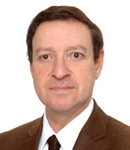 |
Finally, in 2007 I started working in the power generation by nuclear reactors sector when I joined the French utility Electricité de France (EDF) as Special Advisor for Nuclear R&D and International Issues, which is still my current position. Among my various duties I am in charge of relations with Russia and also chair, in Brussels, various groups active in the field of European affairs. I am also a Professor of Nuclear Engineering at Mines ParisTech. |
NC: The European Nuclear Society was created in 1975 as a result of a European initiative to bring together all the nuclear societies in Europe in order that they might share their experiences and discuss all things related to nuclear applications, be it fundamental research, medical applications or energy production. Today, 23 members make up the core of the society, as well as about 60 corporate members that participate in its activities, including EDF, Westinghouse, Paks NPP and GDF Suez.
The activities of ENS are quite similar to those of SFEN and other European national nuclear societies. Our goals are to promote nuclear energy and nuclear science and to spread scientific and technical knowledge about it beyond national borders thanks to events and conferences. We organise events across Europe on a regular basis, like the European Nuclear Conference, Top Fuel and PIME (Public Information Materials Exchange).
NC: I like to see ENS as a federation. We all have different views and expectations, but we try to find a compromise and work together. Every country has a different interest regarding nuclear applications. Among the 28 countries of the European Union half use nuclear as an energy source, while the other half doesn’t.
For instance, France - a strong nuclear-powered country - doesn’t have the same interest as a country like Austria, where the use of nuclear power for electricity production is prohibited by law. Nevertheless, Austria has its full place within ENS and the IAEA’s headquarters and laboratories are actually located in Vienna. In other words, every member country has something to bring in this organization. Our differences are a true challenge, but this fact also makes this kind of organization so interesting and fascinating.
I would not use the word renaissance here since it was rather ‘overused’ between 2005 and 2010. Nuclear energy has always had a future in Europe and this is still the case today.
Our role in this context is to support, defend and explain new projects, for industry and R&D, as well as highlight the techniques and disciplines across the nuclear fields (energy, medicine, research, radiation protection, etc.).
There are at the moment big industrial projects going on in the UK, Poland and Finland, as you said. But we must not forget other challenges that need to be tackled: Germany for instance will have to manage the decommissioning of its plants and their associated spent fuel.
The ENS Young Generation Network (ENSYGN) was created to bring together young professionals from all around Europe and encourage them to share experiences and build together the next generation of the European Nuclear Society. The idea of this network is to enhance contacts and to help develop a common interest in nuclear and its applications. One interesting thing with this network is that it is possible for young generations to exchange today in a way that was not possible for the previous generations for several reasons: language, interests, difficulty traveling, etc.
The European Nuclear Young Generation Forum (ENYGF) has always been a success – as was the case with ENYGF 2013, in Stockholm. In 2015, Paris will host the event and welcome students and young professionals from across Europe and beyond. As the United Nations Conference COP21 will take place in France in December 2015, the central theme chosen for the event is Nuclear Energy and the Environment.
The aim of the event is to give an opportunity to the nuclear young generation to learn about nuclear and its role in fighting climate change, and to build up a network with young professionals from different countries, backgrounds and companies.
It also provides a platform for enhancing international communications, comparing small and large nuclear countries, sharing technical advances and knowledge and learning from experience and best practices.
It also provides a good opportunity to consider the social and political aspects affecting the nuclear industry.
I encourage every student or young professional in Europe to come to Paris in June 2015 and take part in this major event.
My message is that nuclear has a future in Europe, because of its added value to the energy mix in terms of security of supply. The situation is not simple because we are a fragmented continent evenly split between 14 members with nuclear power plants and 14 members without. Some countries are leaving nuclear energy, while others, like Poland, say they want to launch nuclear programmes. There are as many good career opportunities in nuclear as there are in other generation sources within the energy mix.
http://www.euronuclear.org/e-news/e-news-46/interview-choho.htm

(interviewed by Auxence Gros-Borot for the SFEN JG)
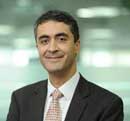 |
I am the head of AREVA’s International Commercial Organisation that numbers around 800 people across the 5 continents and covers all of AREVA’s core businesses: nuclear fuel, reactor design and construction, operating services and renewable energies. |
Based in Paris, at AREVA’s headquarters, my goal is to bring the right sales people to the right negotiation table, so that the AREVA Group meets its commercial objectives. These kinds of decisions, taken in collaboration with AREVA’s business groups and executive management, require regular follow-up and adaptation. I am directly involved in some key negotiations, such as those related to new-build or other sensitive issues. I also promote innovation within the Group, so that we can continue to offer our customers new products and services to help them reach their own objectives and meet their own challenges. My goal is also to promote extended AREVA expertise and increase the sale of innovative global offers that answer all our customer needs - as this is their main priority.
I come from a very technical background and gradually evolved towards more commercial positions, but always in the energy business. I started my career at Gaz De France, where I worked for seven years. I entered the nuclear business when I joined AREVA in 1996 as a Project Manager in the United States. I stayed there 10 years to work on design, project management, and the installation and commissioning of back-end facilities. Later on, I moved towards more sales-oriented positions, respectively in nuclear logistics, nuclear fuel enrichment and fabrication and mining.
In 2011, I was appointed Executive Vice President in charge of sales in Europe, Middle East and Africa, and Vice Chief Commercial Officer. In 2013, I became Chief Commercial Executive Officer and member of AREVA’s Executive Management Board, which supports the Executive Board with the carrying out of its mission.
I am very proud to contribute today to the destiny of such a large commercial group. AREVA is a leader in this historical field, the nuclear industry, and also has great ambition when it comes to renewable energies. This makes it a very thrilling and interesting Group to work for.
I believe that it is a good idea for young professionals interested in this industry to start with a technical job, as this will teach them a lot. And it is crucial in this demanding sector to understand the technical issues. It will also help them to build up credibility and legitimacy for later managing large-scale industrial projects such as nuclear new build.
There are two sorts of businesses at AREVA, roughly divided between long-term agreements (around 10 years) and short-term ones. The first ones are very specific to the nuclear business, especially dismantling, new fuel and reactor builds, while the second ones are quite similar to sales we find in other industries, where price is the key parameter. With regards to nuclear installations, AREVA’s main priorities are safety, performance and quality, while making sure that our offers remain competitive.
In addition, we have to deal with new types of negotiations today as customers ask more and more for global packages for their nuclear installations, integrating reactor financing, fuel supply, the training of operators, etc. This is where AREVA has a strong card to play, as we are one of the only nuclear Groups to be able to offer customers innovative global offers covering most of their needs. We also accompany them throughout their nuclear projects, which involve many different aspects: design and construction of nuclear reactors, fuel supply, used fuel management, plants maintenance and services, trainings, development of local suppliers, etc.
Finally, I personally value trust between negotiators, as trust is the only way to succeed in this kind of sale. The multicultural aspects of the nuclear business also play a key role, and the worldwide presence of the AREVA Group is of great help and very rewarding in this context.
For every large project like a new build venture a team is set up and led by an Offer Director. These teams bring together a lot of people since there is a lot of work to do in relation to technical, licensing, planning, financing and legal aspects. To prepare the offer the team also regularly meets the customer and follows AREVA’s commercial procedures, which are clearly defined and structured with different steps and mandatory milestones that have to be validated by dedicated Offer Committees in order to move the negotiations forward.
When we approach the time for signing the contract fewer people participate in the final negotiations. Each contract is signed following a thorough review by AREVA’s financing, legal and commercial departments and the granting of a written mandate to proceed with the signature.
Local companies play a key role in new build projects and AREVA is deeply committed in supporting and developing, when necessary, local industries and high-skilled jobs. This localisation strategy, systematically deployed by AREVA with every project, allows the Group to benefit from a sound local supply chain, to contribute on-time and on-budget to delivery of the projects and maintain their competitiveness. It also contributes to the development of a qualified local industry that will be able to ensure the operation and the maintenance of the nuclear installations in the long-term. Finally, it allows local companies, once they are part of our global supply chain, to have access to a maximum amount of commercial opportunities - not only on their domestic markets, but also worldwide.
For this AREVA has put in place different mechanisms:
A rigorous identification and qualification programme to identify new suppliers and make sure they answer to the very stringent nuclear requirements
Partnerships between experienced suppliers and newcomers so as to help the latter to ramp-up and adapt to the nuclear industry standards
Supplier training programs to support them with their ramp-up.
AREVA is the world’s leader in the nuclear business, and behind the AREVA brand are more than 50 years of experience and a unique expertise acquired across the entire nuclear industry, including the whole fuel cycle (mining, conversion, enrichment, fuel fabrication and fuel recycling), the design and construction of nuclear reactors and the associated operating services. AREVA provides services to 346 reactors out of the 440 in operation worldwide and work with 95% of the nuclear utilities. New builds are emblematic projects and draw the attention of the media, but 85% of the group’s turnover comes from recurring business i.e. that which excludes new-build projects.
AREVA offers two pressurised water reactors (PWR), the EPR reactor and the ATMEA1 reactor (co-developed with our partner Mitsubishi Heavy Industries). We mainly promote GEN III design, with its high level of safety and the savings in fuel consumption that it offers. We also insist on using the feedback and knowledge that AREVA has accumulated following decades of experience building and servicing hundreds of reactors worldwide with technical skills developed in collaboration with historical partners (EDF and the CEA) and in-house international industrial bases and technical centres, in France, Germany and the USA.
As regards Hinkley Point in the UK, AREVA has been chosen by EDF to build the nuclear steam supply systems (NSSS), including the instrumentation and control (I&C) system for the first two EPR reactors at Hinkley Point. In 2012, AREVA and EDF signed a Memorandum of Understanding relating to the delivery of the NSSS and the I&C and in March 2013 the British Government granted EDF final planning permissions for the project. We are now waiting for the decision of the European Commission regarding the mechanism put in place in the UK to attract investment in nuclear energy and we hope that the project will be launched soon.
Regarding the project at Sinop, in Turkey, the Turkish and Japanese Prime Ministers signed in October 2013 a framework agreement for the Sinop nuclear power plant, establishing the cooperation between the countries, which is at the final stage before a commercial contract. Four ATMEA1 reactors are to be built there. Construction is expected to start in 2017, and power generation for the first unit in 2023. Financing, planning and industrial organisation have still to be defined before the commercial contract can be signed, and we are now preparing the final offer.
Nuclear is and will remain an important component of the world’s energy mix for years to come because we still face the same challenges: if global development keeps its current pace energy demand will be doubled by 2050; furthermore, there is a global objective to reduce greenhouse emissions by 50% by the same date. In addition, the depletion of fossil fuel resources and geographical uncertainties, combined with the need for countries to have energy sources at stable and predictable cost, lead experts to assess that the future of the nuclear energy remains secure. According to the International Energy Agency, nuclear capacity is to increase by about 50% by 2035, which represents an annual growth of 2.2% and a construction effort of about 300GW by 2030 i.e. between 200 and 300 new reactors.
As for AREVA, we have already been chosen for 2 EPR reactors at Hinkley Point in the UK, with an option for 2 additional EPR reactors at Sizewell II – also in the UK - and the 4 ATMEA1 reactors at Sinop, in Turkey.
Discussions are also progressing well for the construction of 2 additional EPR reactors in Taishan (China), Taishan 3 and 4. Poland, Saudi Arabia and the Republic of South Africa are also willing to develop a nuclear industry and we are waiting for the calls for bids to be announced. We have also good prospects in India, and in other countries where technology selection is still ongoing: Brazil, Vietnam and Malaysia.
Knowledge transfer is of paramount importance, not only for the company as a whole, but also for my teams and me. AREVA has always paid particular attention to knowledge transfer, as nuclear is a very specific and specialized sector. Knowledge transfer between new recruits and our experienced staff is essential to ensure the smooth continuation of our projects and the further development of our technologies.
This is a topic that I personally follow closely for my own teams in all our regions as I am convinced that it is one of the keys to mastering regional cultures, establishing long-lasting relationships with our customers and being successful commercially.
Our industry is simply fascinating. Strong technical skills are a must if we want this industry to thrive and the local population to trust us.
The nuclear business is also fascinating because, however rigid it might seem, with all the safety requirements we must abide by, it is actually a forum for innovation where individual effort and ideas are essential to building an ever more secure and sustainable industry and to developing the low-carbon technologies of the future.
http://www.euronuclear.org/e-news/e-news-46/WNA-Symposium2014.htm

The annual WNA Symposium is a unique event in the nuclear conferences and seminars calendar. It brought together a wealth of the world’s top nuclear professionals and companies in order to share knowledge and network. Of the approximately 500 attendees 50% were of a CEO- Director level and 29% of a Senior Manager –Executive level. These statistics show the level of support given to the symposium by industry leaders and showed the potential wealth of industrial knowledge that such an event can harness.
The symposium was held at the Central Hall Westminster, London, from 10-12 September 2014, a location that provided a relaxed but professional environment for delegates. This year’s symposium coincided with the 60th anniversary of civil nuclear energy production and this theme of the past and future was to play a central part throughout the 2 days. The opening session included a memorable address by Sir David King, the Foreign Secretary’s Special Representative for Climate Change at the FCO (Foreign and Commonwealth of the UK Government), followed by other presentations from first Alexander Lokshin, Chief Operational Officer, Rosatom, and then Mohamed Al Hammadi, CEO, Emirates Nuclear Energy Corporation. All the presentations reflected the great achievements that have been made to date in the nuclear energy sector and highlighted the challenges yet to come.
The opening sessions lead nicely into a panel session on the challenges for the industry regarding the fuel cycle, including major threats and opportunities. This session provided a platform for views to be expressed by a panel of senior figures and introduced a novel new way of engaging with the audience via the Symposium’s own mobile phone app. The use of the app consisted of the panel Chairman outlining 5 potential areas for future improvement and asking the audience to vote for what they thought the priority of investment should be. This task provided a further area of comment and debate from the panel and provided an additional way of engaging and gathering opinion from the delegates, something that is an important part of events such as these. This interactive exercise was well received by the attendees.
Breakout sessions and lunch provided an opportunity for delegates to network and visit the range of industry stands on show at the accompanying exhibition. These stands featured both major industrial companies and smaller supply chain members, as well as supporting professional institutions and societies like the European Nuclear Society’s Young Generation Network (ENSYGN - see photo below).
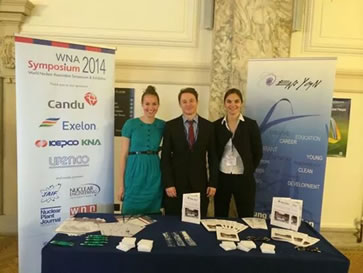
From left to right: Isis Leslie, Project Manager, World Nuclear Association, Nathan Paterson, Validation and Verification Engineer, Rolls-Royce, Eileen Radde Vice-Chair, ENS-YGN.
Day 1 continued with lively presentations on topics such as energy policy, security of fuel supply and concluded with an outline on public perception from different areas of the industry.
Day 2 began with a look at how financial models and the management of liability for nuclear new build projects are progressing from a vendor’s perspective. Mid-morning featured a radiological protection panel session that included academics, industry representatives and policy-makers. Wolfgang Weiss, Representative of the Scientific Committee, UNSCEAR (United Nations Scientific Committee on the Effects of Radiation) gave an account of the observations he had made and the lessons he had learnt from his involvement in the response that was launched to the Fukushima accident - a personal appreciation that was much appreciated.
The penultimate session included presentations on uranium resources from established fuel cycle routes and new areas such as Greenland’s mining activities. The final panel session included various industry leaders such as Tarik Choho, Chief Commercial Executive Officer, Areva; Danny Roderick, President and CEO, Westinghouse Electric Company and Jay Wileman, Chief Operating Officer, GE Hitachi Nuclear Energy - to name but a few. The aim of this session was to understand what the high level challenges and issues will be for the industry for the next 60 years. This prompted comments from the panel on areas such as financing new projects, collaboration, research and development and experienced human resources.
In conclusion the symposium was a very useful platform for networking and debate of the challenges and opportunities the global nuclear industry faces. It was reassuring to hear at the heart of the path ahead included a commitment to building and maintaining a world class workforce across all the areas of the fuel cycle.
Nathan Paterson, Rolls Royce
http://www.euronuclear.org/e-news/e-news-46/sck-cen-award.htm

On 23 October 2014, the biennial Prof Roger Van Geen Prize was awarded at the Belgian Nuclear Research Centre (SCK•CEN).
This year the distinction goes to:
The jury recognised his work on molecular imaging with nanobodies,
which makes a major contribution to the field of oncology and inflammatory and cardiovascular diseases.
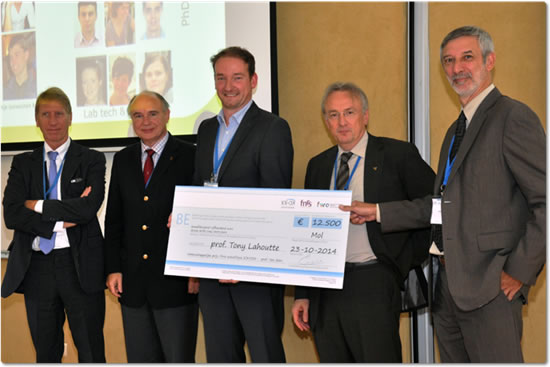
From left to right: Professor Paul De Knop, VUB rector, Professor Derrick P. Gosselin, Chairman of SCK•CEN's Board of Governors, Professor Tony Lahoutte, AZ VUB, Professor Eric van Walle, SCK•CEN Director General, Professor Dirk Ryckbosch, UGent
Molecular imaging is aimed at the study of molecular and cellular events in intact living subjects. At present, nuclear imaging is the most sensitive and accurate method for molecular imaging. It requires the administration of a targeting probe labelled with a radioisotope. In the last five years we have developed radiolabelled nanobodies for molecular imaging applications.
Nanobodies are recombinant proteins that are derived from a particular type of antibodies that exist in the blood of camelids (llama, camel, etc.). In contrast to conventional antibodies that exist in all mammals, the camelid 'heavychain antibodies' (HCAbs) lack a light chain and bind to foreign structures with a single domain called the VHH. This VHH (also called 'nanobody') can be easily produced in bacteria or yeast in large quantities, is very stable and binds to the antigen with high affinities and specificities. Since they are very small, nanobodies penetrate efficiently into dense tissues and an unbound nanobody is eliminated rapidly.
As a result, radiolabelled nanobodies generate very high specific contrast at the targeted site as early as 1 hour after administration. A substantial set of research results (20 publications and 3 patent applications) has been obtained for the development of new molecular imaging tracers based on nanobodies with applications in oncology, inflammatory and cardiovascular disease. This work has been the basis for the translation from bench to bedside of 68Ga-anti HER2 Nanobody: the first clinically tested nanobody for molecular imaging of HER2 expression in breast cancer patients.
Promoting scientific research in the field of nuclear energy is one of the priorities of the Belgian Nuclear Research Centre (SCK•CEN). SCK•CEN's patronage makes it possible for the Research Foundation – Flanders (FWO), in cooperation with the Fonds de la Recherche Scientifique (F.R.S.-FNRS), to grant the biennial scientific award “Prof. Roger Van Geen”. This scientific award of €12,500 is granted every two years to a postdoctoral researcher for outstanding academic research in the field of nuclear energy or radiation. This award should also stimulate collaboration between the Belgian universities, research institutes and SCK•CEN.
Both technically oriented research and studies on the socio-economic aspects of nuclear energy may apply for this award. The submitted work should fit in with or have a potential link to SCK•CEN's research topics.
Prof Roger Van Geen obtained the degree of Licentiate in Physics and Doctor of Sciences at ULB. Later he was professor and dean at the Sciences and Applied Sciences Faculty of VUB (Brussels), where he was appointed rector in 1974. During his rectorate the VUB University Hospital was opened and the construction of an oncological centre and a children’s hospital was started.
In 1975, Prof Van Geen joined the Board of Directors of SCK•CEN. In 1989, he was appointed Managing Director, and as of 1991 was appointed Chairman. Prof Van Geen left a decisive mark on SCK•CEN's scientific ambitions and made a major contribution to the development of a big network of international relations. He also built bridges between politics and human sciences.
http://www.euronuclear.org/e-news/e-news-46/linn.htm

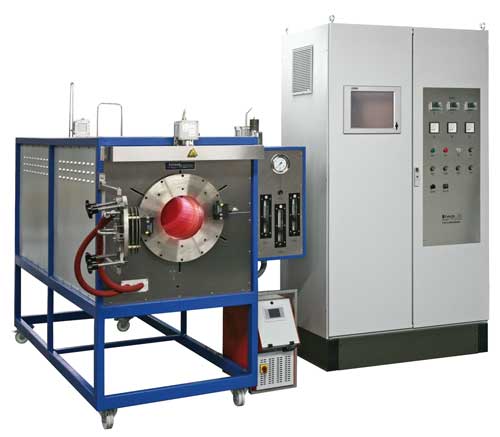
FRH-3-250/2000/850
Tube furnace for fast cycle times.
For heat treatment of powders and granulates, for brazing and annealing processes at inert or reducing atmosphere.
Tmax: 1100 °C
Inside diameter of insert tube (Inconel) appr. 250 mm, length 2150 mm
Heated length: 2000 mm
Heating power: appr. 35 kW
Options: Gas feeding device, burn-off device with flame supervision, several program controllers, temperature measuring by trailing thermocouple, tempering device for door cooling (120 °C) to prevention of condensate, different materials for insert tubes depending of temperature, vacuum.
Adaptable to customer’s individual requirements.

http://www.euronuclear.org/e-news/e-news-46/atomexpo.htm


http://www.euronuclear.org/e-news/e-news-46/l-3.htm

MONTREAL, August 14, 2014 – L-3 MAPPS announced today that it has signed a contract with Daya Bay Nuclear Power Operations and Management Company (DNMC), Ling Ao Nuclear Power Company (LANPC) and Ling Dong Nuclear Power Company (LDNPC) to provide reactor core model-related services for three simulators at the Daya Bay Training Center near Shenzhen, Guangdong Province, China. The project will commence immediately and the simulators are all expected to be in service in the first quarter of 2015.
“It is an honor to continue supplying advanced simulation software and services to our esteemed customers in the China General Nuclear Power Group,” said Michael Chatlani, vice president of marketing & sales for L-3 MAPPS. “Through these updates, we expect to introduce a higher level of consistency between the older Ling Ao and the newer Ling Ao Phase II simulators, while improving the fidelity of the Ling Ao simulator’s reactor model.”
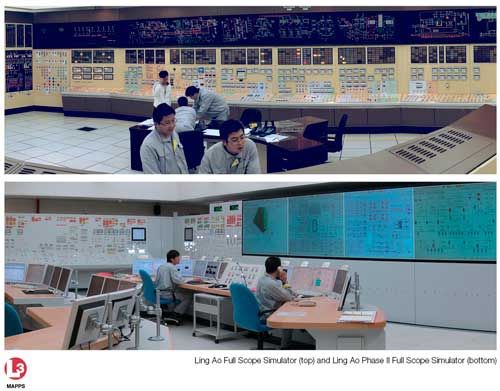
L-3’s Orchid® Core Builder will be employed to update the fuel cycle data to the latest plant fuel cycle data on the two full scope simulators for the Ling Ao Phase II nuclear plant. In addition, Orchid Core Builder will be added to the Ling Ao full scope simulator to make it consistent with the Ling Ao Phase II simulators, the original Comet™ reactor model will be replaced with the Comet Plus™ model, and a similar fuel cycle update will be performed.
Orchid Core Builder is L-3 MAPPS’ graphical utility for the easy creation and validation of cycle-specific reactor core data. The utility generates an advanced reactor kinetics model (Comet Plus) based on the Nodal Expansion Method. Orchid Core Builder is also equipped with an initial condition (IC) transfer mechanism to automate the process of creating ICs following fuel cycle updates.
The Ling Ao Phase II nuclear plant, owned by Ling Dong Nuclear Power Company, comprises the first two CPR1000 nuclear generating units that were put into commercial operation – the first unit in September 2010 and the second in August 2011. The CPR1000 is a Chinese standard design featuring a 1,080-megawatt (MWe) three-loop pressurized water reactor (PWR). The Ling Ao Phase II full scope simulator, built by L-3 MAPPS in cooperation with AREVA and Siemens, was put into service in August 2009.
The Ling Ao nuclear plant, owned by Ling Ao Nuclear Power Company, comprises the two AREVA-designed 938 MWe three-loop PWR units that were put into commercial operation – the first unit in February 2002 and the second in December 2002. The Ling Ao full scope simulator, built by L-3 MAPPS, was put into service in October 2003.
L-3 MAPPS has over 30 years of experience in pioneering technological advances in the marine automation field and over 40 years of experience in delivering high-fidelity power plant simulation to leading utilities worldwide. In addition, the company has more than four decades of expertise in supplying plant computer systems for Canadian heavy water reactors. L-3 MAPPS also provides targeted controls and simulation solutions to the space sector. To learn more about L-3 MAPPS, please visit the company’s website at www.L-3com.com/MAPPS.
Headquartered in New York City, L-3 employs approximately 48,000 people worldwide and is a prime contractor in aerospace systems and national security solutions. L-3 is also a leading provider of a broad range of communication and electronic systems and products used on military and commercial platforms. The company reported 2013 sales of $12.6 billion. To learn more about L-3, please visit the company’s website at www.L-3com.com.
Safe Harbor Statement Under the Private Securities Litigation Reform Act of 1995
Except for historical information contained herein, the matters set forth in this news release are forward-looking statements. Statements that are predictive in nature, that depend upon or refer to events or conditions or that include words such as “expects,” “anticipates,” “intends,” “plans,” “believes,” “estimates,” “will,” “could” and similar expressions are forward-looking statements. The forward-looking statements set forth above involve a number of risks and uncertainties that could cause actual results to differ materially from any such statement, including the risks and uncertainties discussed in the company’s Safe Harbor Compliance Statement for Forward-Looking Statements included in the company’s recent filings, including Forms 10-K and 10-Q, with the Securities and Exchange Commission. The forward-looking statements speak only as of the date made, and the company undertakes no obligation to update these forward-looking statements.
# # #
Orchid, Comet and Comet Plus are trademarks of L-3 Communications MAPPS Inc. All other products are trademarks of their respective companies.
http://www.euronuclear.org/e-news/e-news-46/sck_cen.htm


Please find an overview of the upcoming open courses, organised by SCK•CEN’s Academy for Nuclear Science and Technology.
For all the latest information regarding these training programmes and registration, please consult the Academy website
Training title |
Start |
End |
Language |
Venue |
Link |
Radioprotection |
29-09-2014 |
03-10-2014 |
FR |
SCK•CEN, Mol (Belgium) |
|
Decommissioning of nuclear installations |
06-10-2014 |
10-10-2014 |
EN |
SCK•CEN, Mol (Belgium) |
|
Stralingsbescherming |
13-10-2014 |
17-10-2014 |
NL |
SCK•CEN, Mol (Belgium) |
|
Radiation protection |
17-11-2014 |
21-11-2014 |
EN |
SCK•CEN, Mol (Belgium) |
|
VISIPLAN |
17-11-2014 |
18-11-2014 |
EN |
SCK•CEN, Mol (Belgium) |
|
Preparedness and response for nuclear or radiological emergencies |
16-03-2015 |
20-03-2015 |
EN |
SCK•CEN, Mol (Belgium) |
We are looking forward to welcoming you at one of these courses.
The SCK•CEN Academy Team
http://www.euronuclear.org/e-news/e-news-46/other-conferences.htm

26 - 31 October 2014
Sapporo, Japan
more
29 - 31 October 2014
Moscow, Russia
more

9 - 13 November 2014
Disneyland Hotel, Anaheim, CA, USA
more
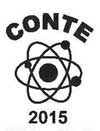
1 - 4 February 2015
Hyatt Regency, Jacksonville-Riverfront, Jacksonville, FL, USA
more

April 2015
Saint-Petersburg, Russia
more
![]()
17 - 21 May 2015
Makuhari Messe
Chiba, Japan
more
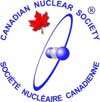
31 May - 3 June 2015
Saint John, NB, Canada
more

1 - 3 June 2015
Moscow, Russia
more

7 - 11 June 2015
Grand Hyatt San Antonio, San Antonio, TX, USA
more
22 - 25 June 2015
Paris, France
more
http://www.euronuclear.org/e-news/e-news-46/Member-Societies.htm

| Austrian
Nuclear Society http://www.oektg.at |
Belgian
Nuclear Society http://www.bnsorg.be |
| Bulgarian
Nuclear Society http://www.bgns.bg |
Croatian
Nuclear Society http://www.nuklearno-drustvo.hr |
| Czech Nuclear Society http://www.csvts.cz/cns |
Finnish
Nuclear Society http://www.ats-fns.fi |
| French
Nuclear Energy Society (SFEN) http://www.sfen.org |
German
Nuclear Society (KTG) http://www.ktg.org |
| Hungarian
Nuclear Society http://www.nuklearis.hu |
The
Israel Nuclear Society E-mail: meins@tx.technion.ac.il |
| Italian
Nuclear Association http://www.assonucleare.it E-mailt: info@assonucleare.it |
Lithuanian
Nuclear Energy Association http://www.lbea.lt |
| Netherlands Nuclear Society http://www.kerntechniek.nl |
The Nuclear Institute http://www.nuclearinst.com |
| Nuclear
Society of Russia E-mail: agagarin@kiae.ru membership on hold |
Nuclear
Society of Serbia http://nss.vin.bg.ac.yu/ |
| Nuclear
Society of Slovenia http://www.djs.si/ |
Polish
Nuclear Society http://www.nuclear.pl |
| Romanian
Nuclear Energy Association (AREN) http://www.aren.ro |
Slovak
Nuclear Society http://www.snus.sk |
| Spanish
Nuclear Society http://www.sne.es |
Swedish
Nuclear Society http://www.karnteknik.se |
| Swiss
Nuclear Society http://www.sns-online.ch |
http://www.euronuclear.org/e-news/e-news-46/Corporate-Members.htm
Links to ENS Corporate Members |
| Aachen Institute for Nuclear Training GmbH link |
AF-Colenco Ltd., Nuclear Technology
Department link |
| Alpiq Ltd link |
Alpiq Suisse Ltd. link |
| Andritz AG link |
Ansaldo Nucleare S.p.A link |
| AREVA NP GmbH E-mail: unternehmenskommunikation @areva.com link |
Atomic Energy Council (AEC) link |
| Atomic Energy of Canada Limited (AECL) link |
Atomexpo LLC link |
| Atomtex SPE link |
Axpo AG link |
| BKW FMB Energie AG link |
Chilean Nuclear Energy Commisssion link |
| Electrabel, Generation Department link |
NV Elektriciteits-Produktiemaatschappij
Zuid-Nederland EPZ link |
| Electricité de France (EDF), Communication Division link |
Euro Nuclear Services BV E-mail: ens@unitech.ws link |
| E.O.N Kernkraft GmbH link |
ENUSA Industrias Avanzadas SA link |
| EXCEL Services Corporation link |
GE Nuclear Energy peter.wells@gene.ge.com |
| IEA of Japan Co. Ltd link |
Kernkraftwerk Gösgen-Däniken
AG link |
| Kernkraftwerk Leibstadt AG (KKL), link |
L-3 Communications MAPPS Inc. link |
| Linn High Therm GmbH link |
Elektroinstitut Milan Vidmar E-mail: mladen.iglic@eimv.si |
| NRG Arnhem link |
NRG Petten link |
| NUKEM Technologies GmbH link |
ONET TECHNOLOGIES link |
| MVM Paks Nuclear Power Plant Ltd link |
Paul Scherrer Institute link |
| Polimaster Ltd link |
Saphymo GmbH link and link |
| Siempelkamp Nukleartechnik
GmbH E-mail: wolfgang.steinwarz@ siempelkamp.com link |
SKB (Swedish Nuclear Fuel and Waste Management
Company) E-mail: info@skb.se link |
| Studiecentrum voor Kernenergie, Centre d’Etude
de l’Energie Nucléaire SCK/CEN link |
SVS FEM link |
| Synatom E-mail: mailmaster@synatom.com |
Taiwan Power Company (Taipower) link |
| Taiwan Atomic Energy Council (AEC) link |
Teollisuuden Voima Oyj / Industrial Power
Company Ltd (TVO) link |
| Tractebel Engineering S. A. link |
UNESA E-mail: nuclear@unesa.es link |
| Urenco Limited link |
Vattenfall AB link |
| VNS – Vinçotte Nuclear Safety link |
VTT Nuclear link |
| Westinghouse Electric Company link |
World Association of Nuclear Operators
(WANO), link |
http://www.euronuclear.org/e-news/e-news-46/editorial.htm

Editorial Staff:
Mark O’Donovan, Editor-in-Chief
Contributors to this Issue:
Noel Carmarcat (ENS)
Frank Deconinck (BNS)
Kirsten Epskamp (ENS)
Auxence Gros-Borot ( SFEN YGN)
Igor Jenčič (Slovenian Nuclear Society)
Juraj Klepac (Slovak Nuclear Society)
Alix Morfoisse ( SFEN YGN)
Nathan Paterson (Rollce Royce)
Dubravko Pevec (HND)
Denis Zeniuk (YGN Ukraine)
Realisation:
Marion Brünglinghaus
Avenue des Arts 56, BE-1000 Brussels
Phone +32 2 505 30 50 - Fax: +32 2 502 39 02
E-mail: info@euronuclear.org - http://www.euronuclear.org
The ENS News is a quarterly publication, in electronic
form only.
Copyright notice ©2014 European Nuclear Society.
Reproduction is authorised provided that the ENS News is acknowledged as the
source – except where otherwise stated.
![]()
© European Nuclear Society, 2014